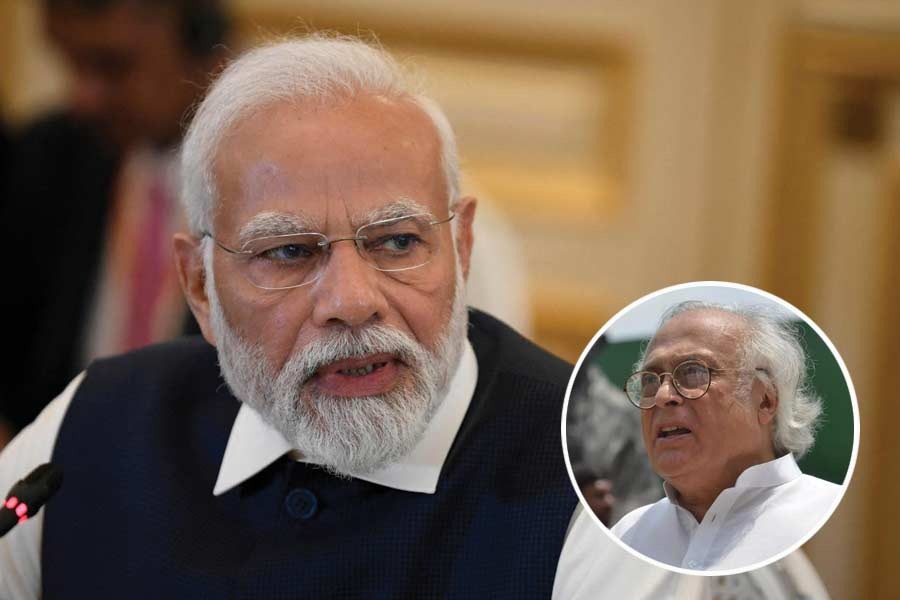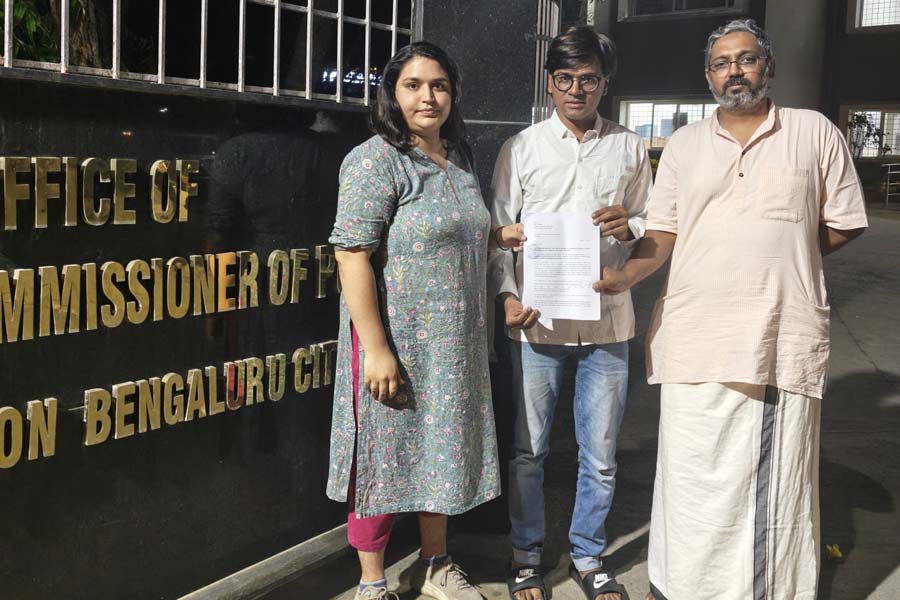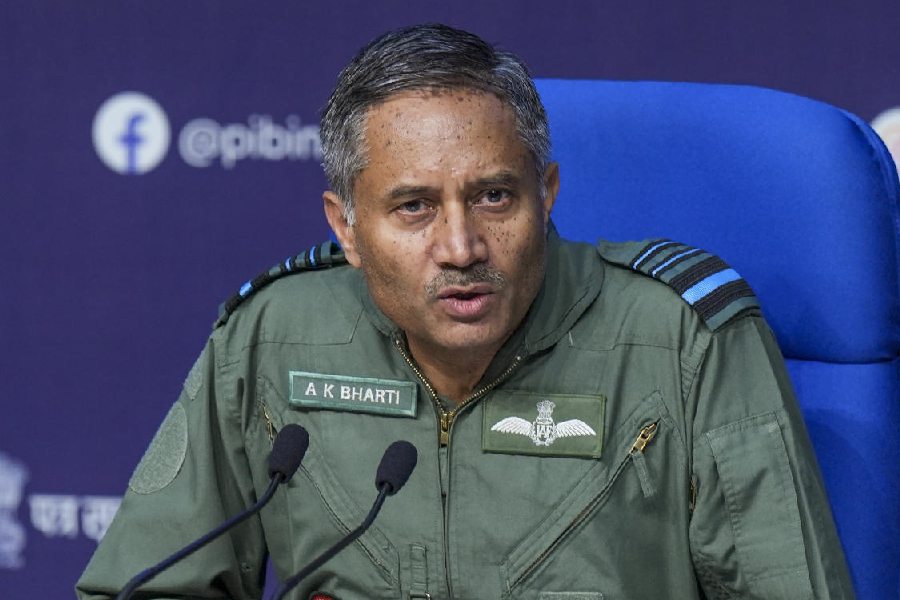If there is one reason why Satyajit Ray's films continue to remain popular with audiences in Bengal two decades after he passed away, it is arguably because they evoke our sense of Bengali identity. And much of Ray's iconic status as a representative of the Bengali bhadralok stems from his liberal public image. This liberalism enabled him, a professed agnostic despite his Brahmo upbringing, to compose a devotional number for Devi, which was his first composition for his films.
Religious events like the Durga Puja feature prominently in some of his most well-known films. The traditionalist in Ray inevitably opts for the ekchala, in which the Goddess and her family reside within the same frame. The 'progressive' agnostic in him appears fascinated by the dualities of the Puja, its combination of religion and culture, of devotion and celebration, and — of fantasy and fact.
Ruku, the six-year-old son of the Ghoshals, has been listening intently to the story of Durga and Mahishasur, and has a question. 'Is this all true?' The old man in front of him, the potter-artist-storyteller Shashi Pal, answers it with a counter-question: 'the sages have written it, how could it be untrue?' This counter-question acknowledges Shashibabu's and our collective inability to answer the most fundamental of questions. Ruku is quick to realise that a clear answer is not forthcoming, and makes up his mind rather quickly too: 'Everything is true. Mahishasur, Hanuman, Captain Spark, Tarzan, Aranyadev, Hijibijbij...'
Children and adults across Bengal would recognise this as the first sequence from Satyajit Ray's film Joi Baba Felunath, which features Ray's detective Felu, his chronicler cousin Topshe and his friend Jatayu, a writer of children's thrillers as fantastic as any mythological story. For a generation that grew up on a steady diet of comic strip characters and their wild stories of impossible adventures, Tarzan and Aranyadev (or Phantom in the English version) fit in perfectly with the mythological Mahishasur and Hanuman, who were increasingly introduced to them by comic books rather than by grandparents.
By the end of the 1970s, Amar Chitra Katha's offerings had begun to occupy pride of place in children's bookshelves. Their thin spines, cheap paper, basic printing and primary colour tones were every bit as attractive as the more expensive comic books like The Adventures of Tintin, also a great favourite of Ray's.
Despite teachers' fears that comics might kill children's appetite for 'real' classics, children grew up, their appetite for 'this trash' and its mixture of fact and fantasy unabated by the disapproval of furrowed brows.
-

Actor Santosh Dutta as Jatayu in Ray's Joi Baba Felunath
The Durga Puja in the background in Joi Baba Felunath is a constant reminder of this duality of fact and fantasy that is such an important part of a child's world, which Ray seems to have understood better than most adults.
In that world, everything that 'exists', whether in real life or fantasy, must be true. And all 'good' beings that emerged victorious in battle, whether it was Durga against Mashishasur, Felu against Maganlal, Akbar against Hemu, a helmetless Gavaskar against the fearsome West Indian speedsters, or a single 'Amitabh' against a gallery of rogues became figures of myth —admired, even venerated.
In this world, myth, fiction, history, reality and fantasy lived together, and were all inescapable fact.
In Ray's Pather Panchali, 22 years before Joi Baba Felunath, reality and imagination co-exist easily in Apu's world. He has been counting the days from at least three weeks before Durga Puja, possibly longer. For him, Durga Puja is about anticipation.
-

A still from Pather Panchali
In the film, the build-up to the Puja is as important as the festival itself. For the village elders like Badyi Majumdar, a community Puja is about organisation, and the occasional foray into nepotism and corruption. Organising the Puja made people look up to him, and only the favoured few like Prasanna, the grocer, were allowed to get away without paying a subscription, in lieu of free supplies of this and that.
Majumdar would invite the best among dhakis whose drums resembled the rolling of thunder, organise stellar jatra performances, incur the jealousy of the organisers in the neighbouring village and conjure such other wonders that comprise the world of fantasy for rural adults. For him, the anticipation of the Puja builds the biggest of these fantasies, the fantasy of power.
For children, the Puja was preceded by a picnic in the woods, the promise of festivity, the girls experimenting with such grown up, 'womanly activity' as unsupervised cooking, amidst excited whispers of weddings near and far.
When the drums rolled, the festival began. Even bitter neighbours became generous, and evenings were spent watching mythological jatra plays, till late into the night.
The morning after, the fantasy was brought back to life as Apu practised wearing the costumes of his fantasy characters in front of a mirror, with moustaches of ribbon and crowns of metal foil.
Durga Puja was a time when figures of myth became 'real', for adults and children alike. The world of adult fantasy, however, is seldom as easily fulfilled as that of children, as it encounters hurdles created by the tyranny of reality.
Apu's father Harihar, an educated man whose continued struggle to earn a living has not been able to stifle his imagination, has thought of a new script for a pala, a jatra play on the myth of Babhrubahan. Babhrubahan is king of Manipur and the son of Arjun and Chitrangada who defeats and kills his estranged father in battle, before giving him his life back again.
It is a curiously prescient story, the theme of the father and his abandoned son returning in the adult Apu's abandonment of his own son in Apur Sansar. Like many of his other plays, Harihar's play too remains just a fantasy, an unrealised promise of literary fame with all the riches that it would bring.
Puja in Pather Panchali marks the fantasy of prosperity for children and adults alike. Everything would be all right after the Pujas: loans would be repaid, homes repaired, promises kept, earnings realised, new clients found, new avenues to wealth discovered. The 'real world' of some adults is as much a mixture of fact and fantasy as the child's world.
For Apu's mother, Sarbojaya, Puja is a reminder of the lack of fulfilment in her life. Even as her husband falls asleep, she stays awake, sewing and stitching, remembering her unfulfilled dreams which she has mentioned before: a suitable groom for her daughter, education for her son, enough food, clothing and shelter, and social esteem and standing for her husband. The dissatisfaction has instead made her a protective, hardworking and harsh mother given to petty thievery, and needlessly cruel to her old widowed sister-in-law Indir so that she may feed her children better. In the season of the goddess, fantasies are a luxury for Sarbojaya and her daughter Durga. They only have unfulfilled dreams.
In Ray's Devi, Durga Puja is a metaphor for a wider tale of cruelty in the world of adult fantasy.
The film opens with Kalikinkar, the zamindar, and his elder son Taraprasad, gazing transfixed at the goddess Durga as the arati is performed for their family Puja. Taraprasad is the very shadow of his father and as the eldest son, clearly expects to succeed him. While Kalikinkar watches the animal sacrifice with a devoted gaze, his sensitive young college-going son Umaprasad, who stands behind him, looks on silently horrified.
-


Stills from Ray's classics Pather Panchali (top) and Devi (above)
A burst of crackers against the night sky follows, watched by Umaprasad, his young wife Dayamoyee, and Taraprasad's son Khoka, with the first strains of Colonel Bogey's March playing in the background.
The final shot is an extended sequence of the immersion ceremony where the goddess, accompanied by thousands of followers who carry her on their shoulders amidst the sound of drums and ritual chanting, is submerged into the waters where the beautiful image of clay once again becomes the earth it was made of.
The opening Puja sequence, then, is the 'story' of Devi in a nutshell. It is the story of Kalikinkar's fantasy, a dream that his daughter-in-law Doyamoyee was the goddess herself, and his perverse effort to 'realise' this delusion by setting up Doyamoyee as an object of worship, to which his eldest son accedes unquestioningly, followed by thousands of his subjects.
The objections of Taraprasad's wife Harasundari are overruled, and the macabre spectacle continues even after Khoka dies, after being entrusted to 'Goddess' Doyamoyee's care during his illness.
The silent Doya accepts everything without question as she has been taught. Her husband Umaprasad's rebellion against his father and his attempt to rescue her from this 'madness' becomes impossible as she begins to share the delusion, which has begun to destroy her inside. The all-powerful goddess is helpless when confronted by the fantasies of powerful men who worship her.
Is it true? Can such things be real? Umaprasad questions his father after listening to the story of Doyamoyee's divinity. Kalikinkar replies with a counter question: the goddess had appeared in his dream. Is that not proof enough that it was true?
Using Durga Puja as its point of initiation, Devi tells the story of the destructive potential of adult fantasy.
The world of the child is flexible enough to allow reality and imagination to co-exist. The realm of some adults, however, like Kalikinkar and his Taraprasad is less tolerant and accommodating.
T he multiple truths of Ruku's and Apu's world have no place in their world of absolute certainties. Both the infant Khoka and the teenage Doya are sacrificed to sustain their fantasies, in which myths become reality, and realities myth.














